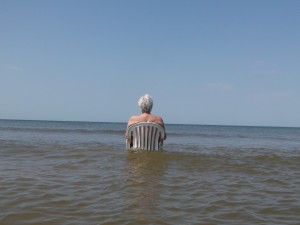Most people don’t know that Latvia has mountains and even fewer know that they are blue. Actually, Latvia has several “Blue Mountains” on its landscape and even a popular play called “Blue Mountain Marta”. But only one of Latvia’s “blue mountains” can be seen from distant Estonia and is located in the Slītere National Park, although you might need a powerful telescope and a vivid imagination to catch a glimpse of it.
The Slītere National Park is located 180 kilometres northwest of Rīga and is best known for its Cape Kolka, that triangle of land that sticks out to seperate the Bay of Rīga from the Baltic Sea. Although Slītere is one of the oldest nature reserves in the Baltic States, several thousand years ago it was entirely under water. (If you want to know what Latvia will look like after global warming raises the seas again, check out a map of the prehistoric Baltic Sea region.)
According to geologists, the Baltic Sea we know and love today was once called the Littorina Sea and was much larger, thanks to a massive meltdown at the end of the last Ice Age. (Of course, there was no one around the Littorina Sea back then, but that doesn’t stop modern-day geologists from naming things after the fact.)
If you drive up north along the Dundaga-Mazirbe highway you will encounter a steep drop in elevation just after you enter Slītere National Park. At this spot you will see a large wooden observation tower to your right. The tower is located on what was once the ancient shoreline of the Littorina Sea and provides a panoramic view of the entire park.
This is also the location of the Slītere “Blue Mountains” although today we tend to be more modest and call them the “Blue Hills”. If you want to get an even better look at the entirety of the Slītere National Park, go to the nearby Slītere light house. From there you get a spectacular view of was once covered by water, as well as the present shoreline of Kurzeme’s “Livonian Coast”.
From the lighthouse you can also see the southern coast of Estonia’s Saaremaa island which is just across the Irbe Strait from Latvia. The Slītere National Park is famous for its broadleaf forests which cover the ancient coastline and have been largely untouched for untold centuries. It’s also famous for housing more animals than humans. While the ancient Livs and modern tourists tend to congregate in the small fishing villages of Mazirbe, Košrags, Pitrags, Saunags,
Vaide and Kolka that lie along the coastline, the inland forests are full of fox, elk, deer, lynx, wild boar and the occasional wolf. The skies are full of birds because the park is located along a major Baltic flyway. As many as 60 000 birds per hour have been observed flying over the forest during the spring and fall migrations.
This flyway is also popular with major international airlines that use this route to wing their way and to and from the Rīga International Airport. Fortunately for the birds (and their watchers) the tourist-packed passenger planes pass a few thousand metres higher in the sky.
If you prefer watching cruising ships to migrating birds, Slitere’s Livonian coastline is great place to gaze at a steady stream cargo container ships and cruise lines as they make their way between Saaremaa and Latvia into the Bay of Rīga.
Want to feel like a Viking? If you happen to be on one of those Baltic ferries, the view you will see of the Livonian coastline is still almost identical to that which ancient Vikings, Teutonic Crusaders and other Baltic seamen saw when they sailed past these shores a thousand years ago. The endless line of green pines, white sands and blue Baltic waters will also reveal why the Livs chose green/white/blue for their national flag.
So no matter how you look at it, or regardless of your vantage point, the Blue Hills of Slītere are a sight to behold. But hurry, because even if urban renewal never invades this remote part of Latvia, sooner or later, the Baltic Sea will. And anyone who has a summer house up there knows that you never really “own” a piece of land on this planet, you just borrow it for a while.
